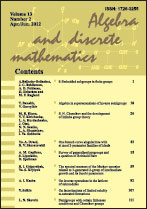|
|
Algebra and Discrete Mathematics, 2003, Issue 1, Pages 20–31
(Mi adm366)
|
 |
|
 |
This article is cited in 1 scientific paper (total in 1 paper)
RESEARCH ARTICLE
Multi-algebras from the viewpoint of algebraic logic
Jānis Cīrulis
Department of Computer Science, University
of Latvia, Raiņna b., 19, LV–1586 Riga,
Latvia
Abstract:
Where U is a structure for a first-order language L≈ with equality ≈, a standard construction associates with every formula f of L≈ the set ‖ of those assignments which fulfill f in \boldsymbol U. These sets make up a (cylindric like) set algebra Cs(\boldsymbol U) that is a homomorphic image of the algebra of formulas. If \mathcal L^\approx does not have predicate symbols distinct from \approx, i.e. \boldsymbol U is an ordinary algebra, then Cs(\boldsymbol U) is generated by its elements \| s\approx t\|; thus, the function (s,t) \mapsto\|s\approx t\| comprises all information on Cs(\boldsymbol U).
In the paper, we consider the analogues of such functions for multi-algebras. Instead of \approx, the relation \varepsilon of singular inclusion is accepted as the basic one (s\varepsilon t is read as `s has a single value, which is also a value of t'). Then every multi-algebra \boldsymbol U can be completely restored from the function (s,t)\mapsto\|s\varepsilon t\|. The class of such functions is given an axiomatic description.
Keywords:
cylindric algebra, linear term, multi-algebra, resolvent, singular inclusion.
Received: 09.10.2002
Citation:
Jānis Cīrulis, “Multi-algebras from the viewpoint of algebraic logic”, Algebra Discrete Math., 2003, no. 1, 20–31
Linking options:
https://www.mathnet.ru/eng/adm366 https://www.mathnet.ru/eng/adm/y2003/i1/p20
|

| Statistics & downloads: |
| Abstract page: | 168 | | Full-text PDF : | 78 | | References: | 5 | | First page: | 1 |
|




 Contact us:
Contact us: Terms of Use
Terms of Use
 Registration to the website
Registration to the website Logotypes
Logotypes









 Citation in format
Citation in format 